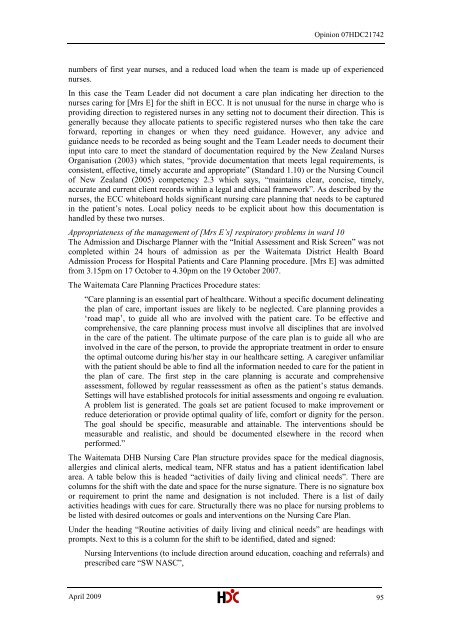North Shore Hospital report - New Zealand Doctor
North Shore Hospital report - New Zealand Doctor
North Shore Hospital report - New Zealand Doctor
Create successful ePaper yourself
Turn your PDF publications into a flip-book with our unique Google optimized e-Paper software.
Opinion 07HDC21742numbers of first year nurses, and a reduced load when the team is made up of experiencednurses.In this case the Team Leader did not document a care plan indicating her direction to thenurses caring for [Mrs E] for the shift in ECC. It is not unusual for the nurse in charge who isproviding direction to registered nurses in any setting not to document their direction. This isgenerally because they allocate patients to specific registered nurses who then take the careforward, <strong>report</strong>ing in changes or when they need guidance. However, any advice andguidance needs to be recorded as being sought and the Team Leader needs to document theirinput into care to meet the standard of documentation required by the <strong>New</strong> <strong>Zealand</strong> NursesOrganisation (2003) which states, ―provide documentation that meets legal requirements, isconsistent, effective, timely accurate and appropriate‖ (Standard 1.10) or the Nursing Councilof <strong>New</strong> <strong>Zealand</strong> (2005) competency 2.3 which says, ―maintains clear, concise, timely,accurate and current client records within a legal and ethical framework‖. As described by thenurses, the ECC whiteboard holds significant nursing care planning that needs to be capturedin the patient‘s notes. Local policy needs to be explicit about how this documentation ishandled by these two nurses.Appropriateness of the management of [Mrs E‘s] respiratory problems in ward 10The Admission and Discharge Planner with the ―Initial Assessment and Risk Screen‖ was notcompleted within 24 hours of admission as per the Waitemata District Health BoardAdmission Process for <strong>Hospital</strong> Patients and Care Planning procedure. [Mrs E] was admittedfrom 3.15pm on 17 October to 4.30pm on the 19 October 2007.The Waitemata Care Planning Practices Procedure states:―Care planning is an essential part of healthcare. Without a specific document delineatingthe plan of care, important issues are likely to be neglected. Care planning provides a‗road map‘, to guide all who are involved with the patient care. To be effective andcomprehensive, the care planning process must involve all disciplines that are involvedin the care of the patient. The ultimate purpose of the care plan is to guide all who areinvolved in the care of the person, to provide the appropriate treatment in order to ensurethe optimal outcome during his/her stay in our healthcare setting. A caregiver unfamiliarwith the patient should be able to find all the information needed to care for the patient inthe plan of care. The first step in the care planning is accurate and comprehensiveassessment, followed by regular reassessment as often as the patient‘s status demands.Settings will have established protocols for initial assessments and ongoing re evaluation.A problem list is generated. The goals set are patient focused to make improvement orreduce deterioration or provide optimal quality of life, comfort or dignity for the person.The goal should be specific, measurable and attainable. The interventions should bemeasurable and realistic, and should be documented elsewhere in the record whenperformed.‖The Waitemata DHB Nursing Care Plan structure provides space for the medical diagnosis,allergies and clinical alerts, medical team, NFR status and has a patient identification labelarea. A table below this is headed ―activities of daily living and clinical needs‖. There arecolumns for the shift with the date and space for the nurse signature. There is no signature boxor requirement to print the name and designation is not included. There is a list of dailyactivities headings with cues for care. Structurally there was no place for nursing problems tobe listed with desired outcomes or goals and interventions on the Nursing Care Plan.Under the heading ―Routine activities of daily living and clinical needs‖ are headings withprompts. Next to this is a column for the shift to be identified, dated and signed:Nursing Interventions (to include direction around education, coaching and referrals) andprescribed care ―SW NASC‖,April 2009 95
















